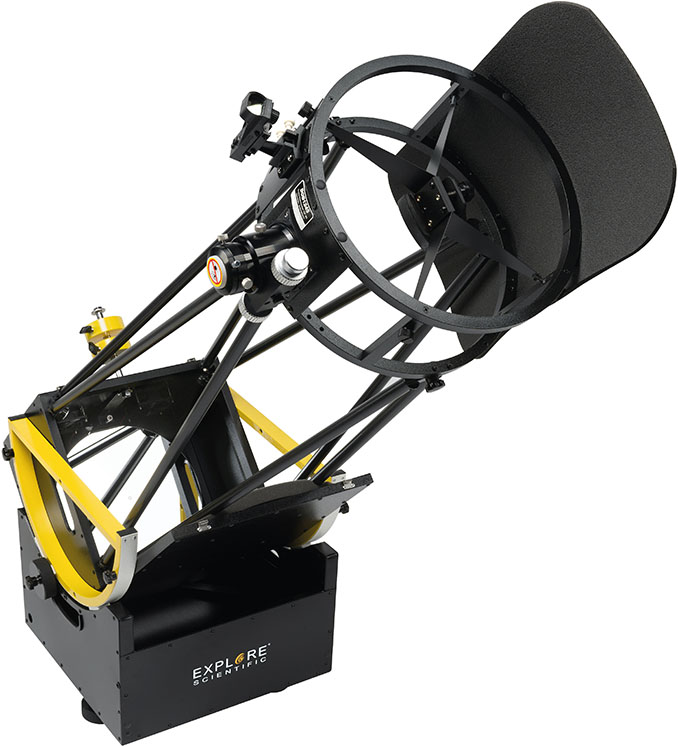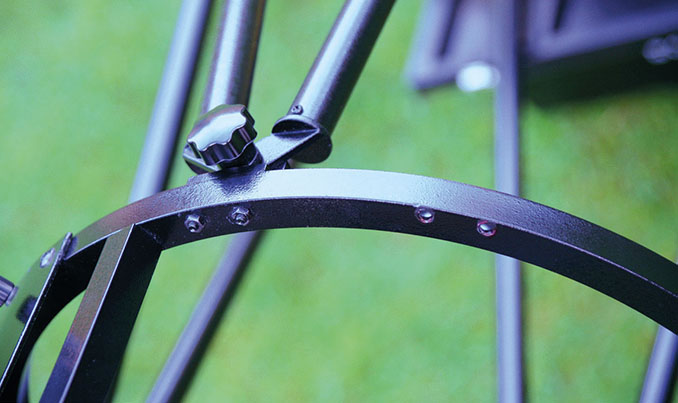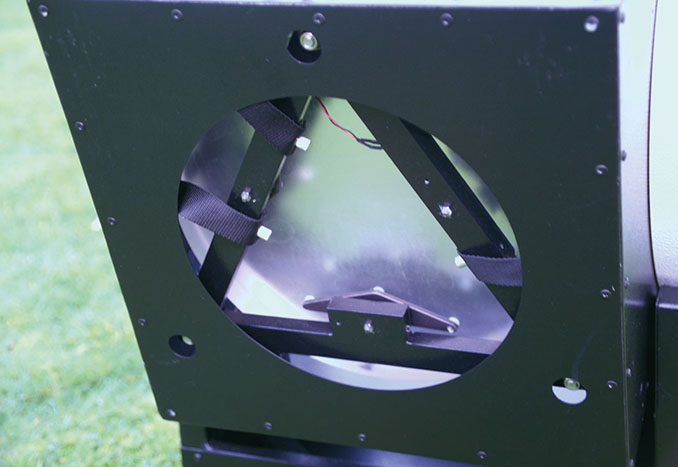A heavyweight Ultra Light Dobsonian – Astronomy Now

The elegant simplicity of Isaac Newton’s two-mirror reflecting telescope design from 1668 has inspired generations of amateur makers. However, not every observer possesses the practical skills (or inclination) to grind and polish their own mirrors, so a little background reading quickly informs you that it’s hard to beat the performance-to-cost ratio of a Newtonian when seeking the largest quality telescope for your money.
Yet even the best telescope is useless without an effective mount and, depending on its sophistication, a mounting can cost many times the cost of the instrument itself. It took nearly 300 years from Sir Isaac’s original proof of concept before John Lowry Dobson (1915–2014) created the minimalist fusion of Newtonian optics with a stable, easy-to-use mount, and hence the Dobsonian was born.
John Dobson lived in the United States from the age of 12, but he was born in Beijing, some 2,000 kilometres north of the city of Guangzhou, currently headquarters of Jinghua Optics and Electronics Co., Ltd. Better known in the West as simply JOC, it’s one of the largest optoelectronic manufacturers in China. JOC owns a number of familiar company names, including Bresser in Germany and Explore Scientific (ES) in the USA.
Explore Scientific currently sells a range of truss-tube Ultra Light Dobsonians encompassing four models of 254mm, 305mm, 406mm and 508mm aperture. The smaller models are both f/5, while the larger are f/4.6 and f/3.6, respectively. Each is modular in design, breaking down into compact, easy-to-assemble units for ease of transportation in even a small car to set up at dark-sky sites.
Unlike traditional Dobsonians, the ES Ultra Light range dispenses with plastic-coated, dense particle board construction in favour of powder-coated aluminium for strength, lightness and resistance to corrosion without the moisture-absorbing qualities of chipboard. Clearly, these are very important qualities in the UK’s maritime climate. For the purpose of this review we obtained (anonymously) a 305mm Explore Scientific Ultra Light Dobsonian for an extensive evaluation during the autumn of 2020.



Delivery and first impressions
The ES 305mm f/5 Ultra Light arrives in a single 49 × 56 × 103 centimetre box that tips your bathroom scales at 34 kilograms, so you can be forgiven for thinking from the outset that ‘Ultra Light’ is something of a misnomer. Once all the packaging is removed you have these components: an 18.9 kilogram primary mirror box (38 × 38 × 29.5 centimetres) containing accessories, a 10 kilogram alt-azimuth rocker box (45 × 44 ×31 centimetres) temporarily hosting the secondary mirror cage, four pairs of 97-centimetrelong truss tubes, a primary mirror collimating tool, two 49-centimetre diameter D-shaped altitude wheels, a foam stray-light shield, a battery pack for the primary mirror cooling fans, a pair of one-kilogram counterweights and their shaft.
The primary mirror box is the heaviest single component of the telescope. This box has a hinged lid locked by two spring-loaded clips that provides ample protection for the primary mirror when stored, or while being carried via a single chrome hinged-handle on the side. The box has a shaped foam insert with a hardboard disc that is of the same diameter as the mirror underneath to provide protection with several layers of tissue paper sandwiched between to prevent contaminants from settling on the primary mirror (more on this later). Cut-outs in the foam hold the red-dot finder and hand-knob bolts used to attach the truss tubes when assembling the telescope.
When the tissue paper was removed, a perfectly coated, gleaming primary mirror with a laser-etched centre mark lay underneath. I was surprised that a separate mirror cover wasn’t provided; an inexpensive vacuum-formed plastic lid with mouldings at the edge to prevent contact with the mirror’s surface would suffice. If you intend reusing the tissue, you must be very careful to prevent contaminants getting sandwiched between it and the mirror.
Once any condensation on the mirror has dried after use, the temptation is to simply leave the foam insert out and close the hinged lid. However, the primary mirror box has open-aperture carrying handles on either side, and dust can easily make its way inside. I’m surprised that some enterprising third-party hasn’t produced covers for ES truss-tube Dobsonian primary and secondary mirrors, for the latter is also only provided with tissue paper for protection.
The pre-assembled alt-azimuth rocker box also provides storage for the fully assembled secondary mirror cage when not in use. This consists of an open-framework cylinder 38 centimetres in diameter and 17 centimetres high that houses the four-vane spider support and collimation mechanism, and the elliptical secondary mirror (7.5 centimetres along its minor axis), with a 50.8mm eyepiece fitting a helical rack-and-pinion focuser and 10:1 reduction gearing on the side of the cage.

Assembly
The first act of assembling the telescope entails attaching the two yellow semi-circular altitude bearings to the sides of the primary mirror box. Two bolts with hand knobs secure each bearing, one going into a threaded hole on the side of the box, the other screwing into the side of the lid to keep it open. The lid also provides additional rigidity for the bearings. A third bolt attaches with the supplied Allen key into a recessed hole so as not to touch the 7.5-centimetre diameter rubber ‘hockey pucks’ on each side that act as as a crude but effective altitude friction brake.
There are two sets of holes on each side of the mirror box and its lid, the front holes reserved for those times when you intend to use heavier two-inch eyepieces – perhaps in conjunction with a coma corrector. I found that using the altitude bearings attached to the front holes altered the telescope’s centre of gravity enough to use a two-inch Antares 40mm Erfle eyepiece, plus all my 1.25-inch eyepieces, without needing to install the supplied counterweight shaft or either/both of its one kilogram masses.
The primary mirror box with attached altitude bearings just lowers into the pre-assembled rocker box. At this stage you need to remove the foam insert containing the finder and truss-tube bolts. The four corners of the upper mirror box possess threaded rods with hand knobs that accept cutouts on right-angled tabs at the hinged ends of each of the four truss pole assemblies. Here on in you are assembling the instrument with the primary mirror exposed, so make sure that you have a head torch to see what you are doing!
The secondary mirror cage attaches to the upper ends of the truss poles using four short bolts with hand knobs, a process that can be somewhat fiddly. I recommend that you do a trial assembly in the daytime first to get acquainted with the process, which, by night, will definitely require a head torch. Recall that the secondary mirror is solely protected by tissue paper. A clean plastic drink or washing-up bottle, with the end cut off and four equidistant slots cut into it for sliding over the four-vane spider support, would protect the secondary mirror from accidental damage and dust during set-up and subsequent disassembly.
The secondary mirror cage can be attached to the trusses in one of four orientations that position the focuser upwards, to the left or right side, or towards the ground. However, the secondary cage truss mounting lugs can be moved to an intermediate set of holes, affording a total of eight possible positions for your viewing comfort. With the experience of performing trial set-ups and disassemblies in daylight, it’s quite possible…
Read More: A heavyweight Ultra Light Dobsonian – Astronomy Now

